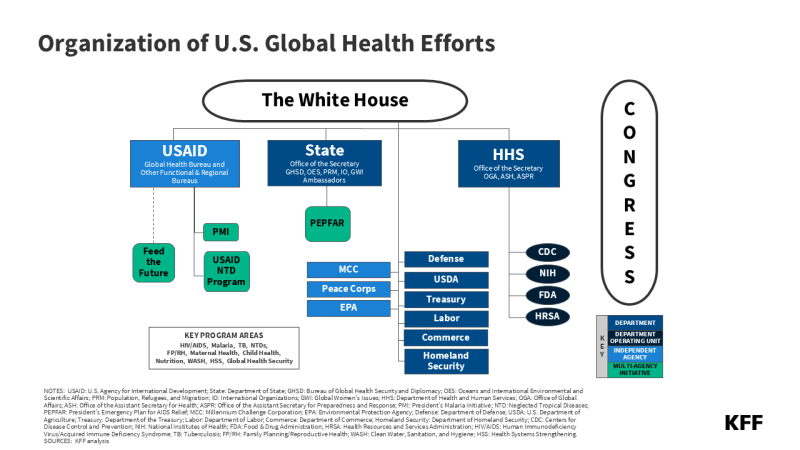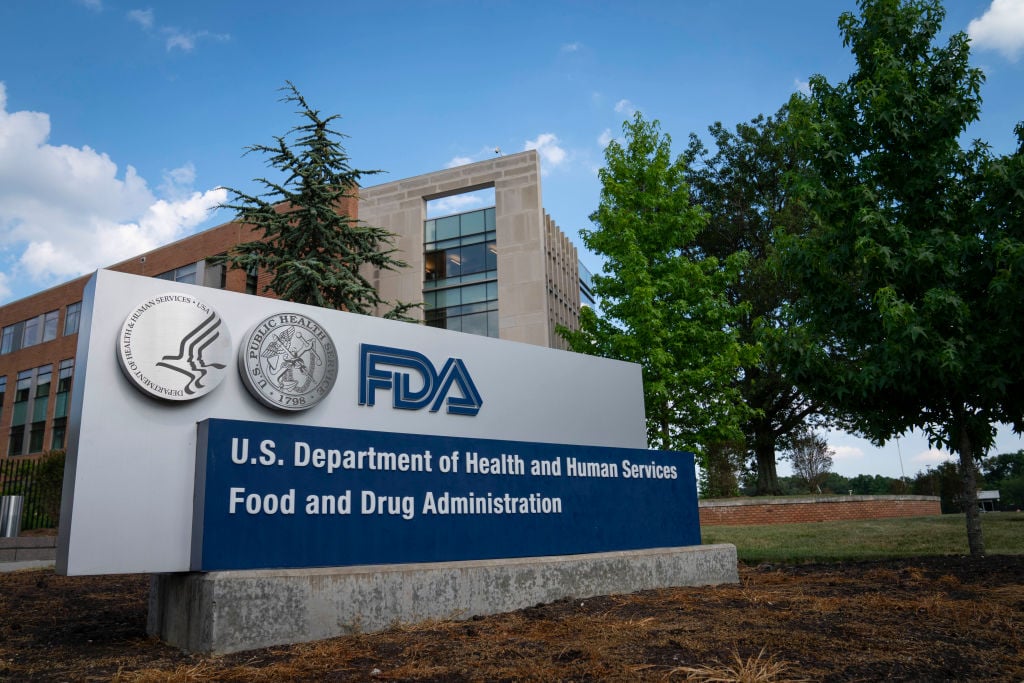Key Facts
- U.S. government (U.S.) global health efforts aim to help improve the health of people in low- and middle-income countries while also contributing to broader U.S. global development goals, foreign policy priorities, and national security concerns.
- The U.S. has been engaged in international health activities for more than a century and today is the largest funder and implementer of global health programs worldwide.
- Many different U.S. government departments and agencies, congressional committees, and funding streams are involved in these efforts.
- Through both bilateral programs and multilateral engagement, the U.S. supports activities that address a range of global health challenges (including but not limited to HIV, malaria, family planning and reproductive health, maternal and child health, and global health security) in approximately 80 countries.
- Total U.S. global health funding through regular appropriations was approximately $12.3 billion in FY 2024, up from $5.4 billion in FY 2006; additionally, supplemental funding has been provided in response to emergencies, such as Ebola, Zika, and the COVID-19 pandemic, in certain years.
Why Is the U.S. Engaged in Global Health?
U.S. global health efforts aim to help improve the health of people in developing countries while also contributing to broader U.S. global development goals (e.g., advancing a free, peaceful, and prosperous world), foreign policy priorities (e.g., promoting democratic institutions, upholding universal values, and promoting human dignity), and national security concerns (e.g., protecting Americans from external threats, sustaining a stable and open international system). For these reasons, the U.S. government has been engaged in international health activities for more than a century and today is the largest funder and implementer of global health programs worldwide. The U.S. global health response – a key component of the U.S. international development portfolio, accounting for about 17% of the international affairs budget – is a multi-pronged, multi-billion dollar investment that targets a myriad of global health challenges, countries, and stakeholders. Efforts involve many different U.S. government departments and agencies, congressional committees, and funding streams.
What Is the U.S. Role?
The U.S. role in global health is multifaceted. The U.S. government:
- acts as a donor by providing financial and other health-related development assistance (e.g., commodities, like contraceptives, or bed nets for protection from disease-carrying mosquitoes) to low- and middle-income countries;
- operates programs and delivers health services;
- provides technical assistance and other capacity-building support;
- participates in major international health organizations through global health diplomacy and other efforts;
- conducts research;
- supports international responses to disasters and other emergencies; and
- partners with governments, non-governmental groups, and the private sector.
What Agencies and Departments Are Involved?
The U.S. engagement in global health is largely carried out by executive branch departments and agencies (see organization chart below), but the legislative branch also plays an important role.
Executive Branch
Day-to-day, U.S. global health activities are administered through arms of the government, including: the White House through its National Security Council (NSC), which acts to coordinate national security and foreign policy decisions across federal agencies, with staff focused on development, global health, and humanitarian response as well as global health security and biodefense, along with the White House’s Office of Pandemic Preparedness and Response Policy (OPPR) and Office of Science and Technology Policy (OSTP); the Department of State through its new Bureau for Global Health Security and Diplomacy (GHSD), which coordinates the Department’s work on global health security and HIV, including PEPFAR, as well as provides diplomatic support (through U.S. Ambassadors and others) in implementing U.S. global health efforts; the U.S. Agency for International Development (USAID), which leads U.S. international development assistance and implements U.S. global health programs including through its Bureau for Global Health; and Department of Health and Human Services (HHS) operating divisions, particularly the Centers for Disease Control and Prevention (CDC), which works to prevent, detect, and respond to disease threats around the world including through its Center for Global Health, and the National Institutes of Health (NIH), which conducts behavioral and biomedical science research, including global health research, on diseases and is the largest public funder of biomedical research in the world. Additionally, the HHS Office of Global Affairs leads the department’s engagement with bilateral and multilateral partners.
Legislative Branch
Congress introduces, considers, and passes global health-related legislation; oversees global health efforts; authorizes and appropriates funding; and confirms presidential appointees to key U.S. global health positions. See the KFF primer on Congress and global health.
What Types of Efforts Are Supported?
The U.S. government supports a wide array of bilateral and multilateral global health efforts in countries around the world, partnering with numerous community and private sector organizations, as well as other governments and international and multilateral organizations, to carry out its global health activities:
Bilateral Efforts
U.S. bilateral (two-party; country-to-country; U.S. support that is for the benefit of another country and is provided to a government, NGO, or other group for this purpose) programs provide direct support to approximately 80 low- and middle-income countries and typically operate in a particular set of countries with their own budgets, staff, strategies, objectives, and monitoring and evaluation practices; they often involve multiple U.S. agencies/departments. See “What Are the Major Programs?” below.
Multilateral Efforts
U.S. support for multilateral (multi-country, usually through an international organization involving or supported by multiple governments; U.S. support provided to a multilateral organization is channeled to support programs in or benefitting other countries) global health efforts includes:
- making financial contributions to international organizations (e.g., Gavi, the Vaccine Alliance [Gavi], and the Global Fund to Fight AIDS, Tuberculosis and Malaria [the Global Fund]) and United Nations agencies (e.g., the United Nations Children’s Fund [UNICEF]);
- serving as a member-nation of large multilateral health organizations (e.g., the World Health Organization [WHO] – see the KFF fact sheet);
- participating in multilateral governance (e.g., as a Board member of an organization);
- serving as signatory to international health standards, treaties, and agreements;
- providing technical assistance to international organizations; and
- providing additional staff capacity to international organizations (by detailing U.S. government employees to these organizations for periods of time).
What Are the Major Programs?
HIV/PEPFAR
While the U.S. first provided funding to address the emerging global HIV epidemic in 1986, funding and attention has increased significantly in the last decade, particularly following the 2003 announcement of the President’s Emergency Plan for AIDS Relief (PEPFAR) by President Bush. PEPFAR’s launch led to a major increase in U.S. support for HIV prevention, treatment, and care efforts, as well as contributions to the Global Fund, the Joint United Nations Programme on HIV/AIDS (UNAIDS), and the International AIDS Vaccine Initiative (IAVI). The Department of State’s U.S. Global AIDS Coordinator oversees this government-wide effort, which is implemented by USAID, CDC, and other agencies. See the KFF fact sheet on the global HIV/AIDS epidemic, the KFF fact sheet on U.S. PEPFAR efforts, and the KFF fact sheet on the U.S. and the Global Fund.
Tuberculosis (TB)
USAID began its global TB control program in 1998, and since that time, the U.S. response has grown, particularly expanding after 2003 when the U.S. government’s commitment to addressing TB was highlighted as part of PEPFAR. Today, led by USAID and implemented by and involving several agencies, U.S. TB efforts focus on diagnosis, treatment, and control of TB (including multi-drug resistant and extensively drug-resistant TB [MDR/XDR TB]) and on research. The U.S. is also a donor to the Global Drug Facility of the Stop TB Partnership, a global network of public and private entities working to eliminate TB. See the KFF fact sheet on U.S. TB efforts.
Malaria/PMI
Engaged in malaria work since the 1950s, the U.S. supports malaria efforts through the President’s Malaria Initiative (PMI, launched in 2005) as well as other activities, including research. PMI programs, overseen by USAID’s U.S. Global Malaria Coordinator and implemented by USAID and CDC, center on expanding coverage of six key high-impact interventions: diagnosis of malaria and treatment with artemisinin-based combination therapies (ACTs), entomological monitoring, intermittent preventive treatment in pregnancy (IPTp), indoor residual spraying (IRS) with insecticides, insecticide-treated mosquito nets (ITNs), and seasonal malaria chemoprevention (SMC). See the KFF fact sheet on PMI and other U.S. malaria efforts.
Neglected Tropical Diseases (NTDs)
Having historically engaged in NTD efforts through research and surveillance, the U.S. expanded its response by launching the USAID NTD Program in 2006, which aimed to reduce the prevalence of seven NTDs (ascariasis or roundworm, hookworm, trichuriasis or whipworm, lymphatic filariasis or elephantiasis, onchocerciasis or river blindness, schistosomiasis or snail fever, and trachoma) through integrated treatment programs using mass drug administration (MDA), and the U.S. NTD Initiative in 2008, which aimed to intensify efforts and increase funding for activities across the U.S. government. Efforts are led by USAID and involve CDC, the National Institutes of Health (NIH), and other agencies. See the KFF fact sheet on U.S. NTD efforts.
Family Planning/Reproductive Health (FP/RH)
The U.S. has been engaged in international research on FP and population issues as well as other FP/RH efforts, including the purchase and distribution of contraceptives in developing countries, since the 1960s. Today, led by USAID and involving several agencies, U.S. FP/RH activities are designed to decrease the risk of unintended pregnancies and maternal and child mortality through effective interventions, including contraception, counseling, and post-abortion care. See the KFF fact sheet on U.S. FP/RH efforts and the KFF fact sheet on statutory requirements and policies related to these efforts.
Maternal and Child Health (MCH)
The U.S. has been involved in efforts to improve MCH since the 1960s. Today, led by USAID and involving several agencies, U.S. MCH activities aim to: improve equity of access to and use of services by vulnerable populations; bring to scale a range of high impact interventions that mitigate maternal, newborn, and under-five deaths; prevent and address the indirect causes of such deaths (such as HIV, TB, and malaria); strengthen integration of maternal health services with FP; and strengthen health systems. Additionally, some water, sanitation, and hygiene (WASH) activities are part of the environmental health efforts within the USAID MCH program. The U.S. is also a donor to global organizations addressing MCH, like Gavi; UNICEF; and the Global Polio Eradication Initiative (GPEI). See the KFF fact sheet on U.S. MCH efforts, the KFF fact sheet on U.S. polio efforts, and the KFF fact sheet on the U.S. and Gavi.
Nutrition/Feed the Future
For more than 40 years, USAID has been involved in nutrition efforts, aiming to prevent undernutrition through interventions such as nutrition education, nutrition during pregnancy, exclusive breastfeeding, and micronutrient supplementation. USAID’s nutrition efforts are coordinated with the U.S. Feed the Future Initiative (FtF, launched in 2009), which aims to address global hunger and food security and is led by USAID with several U.S. government agencies including the U.S. Department of Agriculture. See the KFF fact sheet on U.S. MCH efforts (which includes U.S. nutrition efforts).
Global Health Security
While the U.S. government has supported global health security (GHS) work for more than two decades, its involvement has expanded over time, with attention to these efforts growing significantly due to the COVID-19 pandemic. Meant to reduce the threat of emerging and re-emerging diseases by supporting preparedness, detection, and response capabilities worldwide, U.S. GHS efforts are primarily carried out by the White House, USAID, CDC, the Department of Defense (DoD), and the Department of State. The U.S. has also played a key role in development of the “Global Health Security Agenda (GHSA),” an international partnership launched in 2014 and now involving more than 70 countries and international organizations. Through the GHSA, U.S. government agencies work with host governments and partners to help countries make measurable improvements in capabilities to detect and respond to emerging disease events and achieve global health security targets. Further, in 2022 the U.S. was an early supporter and is the largest funder of the Pandemic Fund, a multilateral global financing mechanism that aims to help countries build their capacity to prevent, prepare for, and respond to epidemics and pandemics. See the KFF brief on the U.S. GHS efforts.
Where Do These Programs Operate?
U.S. global health efforts are carried out in approximately 80 countries through bilateral support to countries or through regional programs. The majority of countries reached through bilateral support are located in sub-Saharan Africa (35 countries), followed by the Western Hemisphere (16 countries), East Asia and Oceania (11 countries), South and Central Asia (9 countries), Europe and Eurasia (4 countries), and Middle East and North Africa (4 countries) (see the KFF tracker on U.S. global health programs by country and region). Additional countries are reached indirectly through U.S. contributions to multilateral organizations. The U.S. typically operates multiple global health programs in most of the countries. While more support is generally directed to countries facing a higher burden of disease, other factors influencing where U.S. health assistance is directed include the presence of willing and able partner governments; a history of positive relations and goodwill with host countries; strategic and national security priorities; funding; and personnel availability.
How Much Funding Is Provided?
The U.S. is the largest donor to global health in the world, and its investment in global health has grown significantly since the early 2000s. However, since FY 2010, U.S. funding for global health has remained relatively flat, with spikes in some years due to emergency supplemental funding for disease outbreaks (see figure below). Key highlights and funding trends include (also see KFF’s U.S. global health budget tracker and fact sheets):
- funding for global health is channeled through multiple agencies and programs; most funding is provided by Congress to the Department of State (largely because most PEPFAR funding is channeled through the department), followed by USAID, HHS, and DoD;
- the majority of U.S. funding for global health (around 80%) is captured under the Global Health Programs account, with an additional $1-2 billion per year for global health activities provided through other accounts;
- most U.S. global health funding goes to HIV programs, which have received the most funding of any U.S. global health program since FY 2001 and have historically accounted for approximately half of total funding through regular appropriations;
- most funding (approximately 80% in the last decade) is provided bilaterally with the remainder provided to multilateral organizations, such as the Global Fund and Gavi (see the KFF brief on U.S. multilateral global health engagement); and
- most U.S. global health funding designated for specific country and regional efforts is allocated to sub-Saharan Africa, followed by South and Central Asia, the Western Hemisphere, East Asia and Oceania, the Middle East and North Africa, and Europe and Eurasia.
Publisher: Source link










